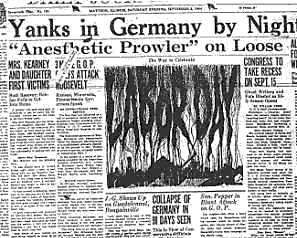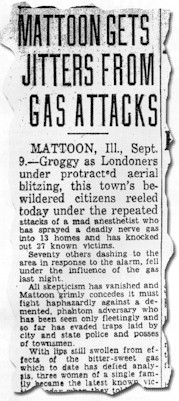| |
Unexplained Mysteries - Mad Gasser of Mattoon |
|
Source : http://en.wikipedia.org/wiki/The_Mad_Gasser_of_Mattoon
 |
|
The Mad Gasser of Mattoon (also known as the "Anesthetic Prowler", the "Mad Anesthetist", the "Phantom Anesthetist", the "Mad Gasser of Roanoke", or simply the "Mad Gasser") was the name given to the person or people believed to be responsible for a series of apparent gas attacks that occurred in Botetourt County, Virginia, during the early 1930s, and in Mattoon, Illinois, during the mid-1940s.
Whether the attacks were anything more than a case of mass hysteria, if the individual reports were connected, and the ultimate explanation for the events all remain debated.
On September 2, 1944, as the Second World War was in progress in Europe and the Pacific, some strange happenings were reported in the small town of Mattoon, Illinois. The front page of the town’s newspaper described a mysterious attack by an “Anesthetic Prowler” the previous evening. A young housewife named Aline Kearney had been laying in bed reading the newspaper when she noticed a strong, sweet odor seeping into the room. The smell made her and her three-year-old daughter feel ill, but when Aline tried to get out of bed, she found that she couldn’t move her legs.
Aline’s sister was staying at the house, and upon learning of the strange odor and its ill effects, she dashed to a neighbor’s house to have them contact the police. When the police investigated they found nothing out of the ordinary, but when Aline’s husband arrived at home at 12:30am from his job as a cab-driver, he discovered a prowler outside the bedroom window. He gave chase, yet the unknown lurker escaped. When the police were summoned back, they again found nothing. Real or imaginary, the dark figure would soon come to be known as the Mad Gasser of Mattoon, and this ambiguous individual would be blamed for dozens of such attacks in the following weeks.
Such is how the story was told in the Daily Journal-Gazette the following day, under the headline “‘Anesthetic Prowler’ on Loose.” The subheading ominously declared, “Mrs. Kearney and Daughter First Victims.” In using the term “first,” it seems that either the Gazette reporters had an uncanny predictive ability, or they had a flair for the dramatic. In the days following the news report, three other citizens came forward claiming that they had been the victims of “gassings” before the event at the Kearney house. People spoke of lightheadedness, paralysis, upset stomach, and vomiting, accompanied by a sickly-sweet odor.
A few days later on September 5, Mrs. Carl Cordes reported finding a small wet cloth on her porch, and when she picked it up she was overcome by an odor. “It was a feeling of paralysis,” she reported, “My husband had to help me into the house and soon my lips were swollen and the roof of my mouth and my throat burned. I began to spit blood and my husband called a physician. It was more than two hours before I began to feel normal again.”

Other newspapers quickly picked up the story, and soon the entire country was reading about Mattoon’s rumored mad gasser. For months, U.S. newspapers had been warning Americans that the Nazis might employ poison gas in attacks against civilians, so this sort of story sold a lot of newspapers to jittery citizens.
Reports of “gassings” continued, and increased daily. On September 8, the Gazette published an editorial criticizing police for not taking Aline Kearney’s report seriously. Shortly thereafter, ten Illinois state police officers were assigned to the case, as well as two agents from the FBI.
Before long, police began to receive reports of several attacks each night. Many victims reported a tall figure dressed in black fleeing from their property immediately after the attacks, as well as blue vapors and buzzing sounds. The Gazette continued its coverage as people throughout the country read of the events unfolding in Mattoon. Soon, large groups of armed citizens were roaming the town at night, following any police cars that were speeding off to investigate another attack. Police officers were ordered to start arresting the chasers, and tensions mounted.
On September 13th, eight days and three dozen victims later, the reports of attacks abruptly halted. Investigators were at a complete loss for an explanation. Careful searches found no chemical evidence of harmful gasses, and all of the victims were completely free of any lingering symptoms.
The only suspect ever investigated in the attacks was a man named Farley Llewellyn. He was a student of chemistry, and he was bitter because he had been ostracized by the community as a suspected homosexual. He seemed a compelling suspect because he had the means and the motive, and most of the alleged attacks occurred near his home. But even after he was placed under constant surveillance, the reports of the attacks had continued.
To this day, it is unclear who was responsible for the attacks, if anyone. Some have postulated that pollutants from nearby factories and industrial plants may have been the cause, but each report was so localized as to cast that possibility into doubt. The official investigation ultimately dismissed the Mad Gasser as an artifact of mass hysteria fed by the newspapers, which is certainly not outside the realm of possibility. It wouldn’t be the first nor the last time that human imagination and embellishment conjured a threat from nothing.
Botetourt County, Virginia
The first actually recorded Mad Gasser incident occurred in Botetourt County, Virginia, with attacks occurring between December 22, 1933 and February 1934.
Chronology
The first reported gasser incident occurred at the home of Cal Huffman, in Haymakertown, Botetourt County, where there were three reported attacks over the course of a single night.
At about 22:00 Hrs on December 22, 1933, Mrs. Huffman reported smelling an unusual odor, and was overcome by a feeling of nausea. The odor and the nausea returned again at about 22:30 Hrs, at which time Cal Huffman contacted the police. A third attack occurred around 01:00 , this time affecting the entire house; in total, eight members of the Huffman family were affected by the gas, along with Ashby Henderson, a guest staying at the house. Their symptoms included headaches, nausea, facial swelling, and constriction of the mouth and throat. Alice Huffman, the daughter of Cal Huffman, suffered a more severe reaction to the gas than the other residents: her throat became so constricted that she stopped breathing and had to be resuscitated. She also suffered convulsive fits for several weeks after the attack, though local physician S.F. Driver recorded at the time that this was most likely due to anxiety brought on by the attack, rather than the effects of the gas itself.
The next recorded incident occurred in Cloverdale on December 24. Clarence Hall, his wife, and their two children returned from a church service at about 09:00 Hrs. They detected a strong, sweet odor and immediately began to feel weak and nauseated. Police investigating the case discovered that a nail had been pulled from a rear window, near where the gas appeared to be the most concentrated, and presumed that the nail hole had been used to inject it into the house.
A third incident occurred on December 27, in which Troutville resident A. Kelly and his mother reported similar signs and symptoms to the Huffman and Hall cases. A fourth and fifth incident occurred on January 10, when Mrs. Moore, a guest in home of Haymakertown resident Homer Hylton, reported hearing voices outside before gas was injected into the room through a damaged window. The second attack that night was reported in Troutville, at the home of G. Kinzie.
Toxic waste or pollution
On September 12, Chief of Police Cole told a press conference that odors and symptoms reported may have been the result of pollutants or toxic waste released by nearby industrial plants, and speculated that carbon tetrachloride or trichloroethylene, both of which have a sweet odor and can induce symptoms similar to those reported by purported gasser victims, may have been the substance released.
In response to Cole's statement, Atlas-Imperial, the primary company implicated in this affair, released a statement of its own saying that their facility had only five gallons of carbon tetrachloride in stock, which was contained in firefighting equipment. Atlas-Imperial officials also denied that any quantities of trichloroethylene (an industrial solvent used by Atlas) could be responsible for sickness in the town, reasoning that it would have taken significant quantities of the chemical to sicken the townspeople, and that factory workers would have experienced similar symptoms long before anybody outside of the factory was affected.
At the time of the gassing, the Atlas plant had been certified as safe by the State Department of Health.
Actual assailant
After analyzing events, some researchers have concluded that at least some of the gasser incidents were the work of an actual attacker who carried out a series of gassings as reported by witnesses.
Whether the events in Botetourt and Mattoon are connected remains a point of conjecture. Author Mike Dash argues that there are striking similarities (female footprints and similar smells/symptoms) but does not insist upon a connection. Jerome Clark also notes many similarities between the two cases but stops short of arguing in favor of a link. Clark rejects the idea that the Virginia case inspired the Mattoon case, either as a mass hysteria or due to a "copycat effect". The two incidents took place nearly a decade apart in different locations and argues that the former received little publicity outside of the immediate areas.
Farley Llewellyn
In 2003, Scott Maruna, a former resident of the area affected by the 1944 Mattoon incident, self-published a book detailing his hypothesis that the attacks were the work of a mentally disturbed man named Farley Llewellyn.
Maruna writes that Llewellyn, who was studying at the University of Illinois at the time of the attacks, was an accomplished chemistry student who was isolated from the local community because of suspicions that he was a homosexual, allegedly giving him both the knowledge and the motive to commit the attacks. Maruna argues that many of the attacks were clustered around Llewellyn's home and that the first victims had attended high school with him.
In addition to naming him as the gasser, Maruna also claimed that Llewellyn's two sisters, Florence and Kathryn Llewellyn, were involved, and that they had carried out one or more attacks in order to draw suspicion away from their brother.

Submit News/Videos/Links |
Discuss article |
Article Link
|
More unsolved mysteries on Unexplained Mysteries
|



![]()